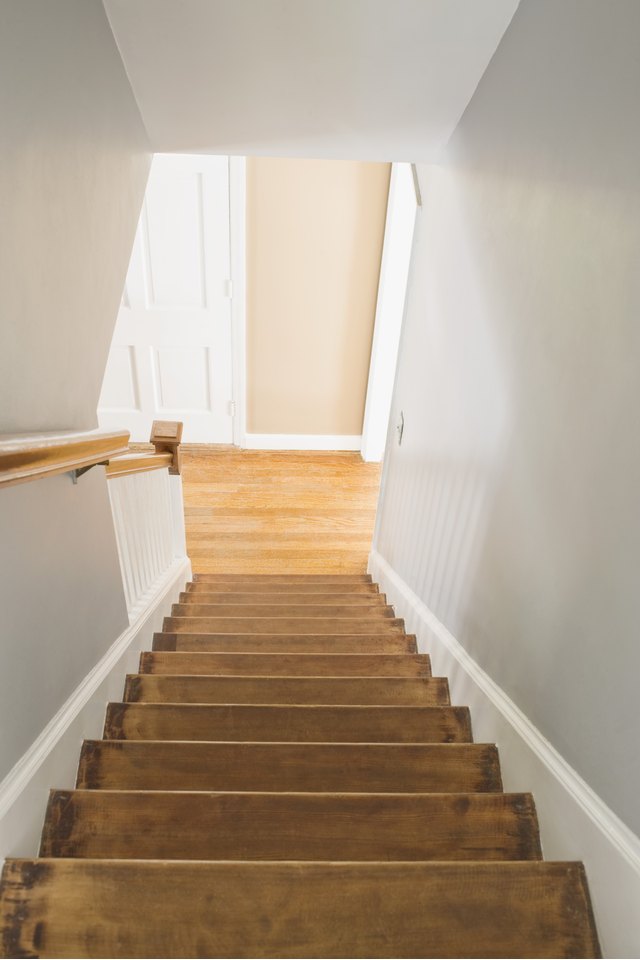Knee Exercises for Going Down Stairs

Walking down stairs is a more active task than we tend to think. The amount of impact the knee absorbs with each step and the number of muscles activated by the motion activates the whole body. Focusing on strengthening and stretching certain muscles in the legs can give your knees some added assistance as they keep you moving down the stairs.
Knee Structure
The knee is a complex joint where a network of bones and soft tissue join the upper and lower leg. The joint also allows the leg to bend for functional movement like walking running, sitting and bending. The large quadriceps muscle of the upper leg inserts into the knee via the quadriceps tendon, and the muscles of the shin and lower leg attach to the knee through the patellar tendon. The knee cap nestles in the condyle indentation of the femur and protects the anterior and posterior cruciate ligaments The knee cap also protects the tendon insertion of the hamstring muscles and the tendon origin of the calf muscles at the back of the knee.
Moving Down Stairs
Your knees handle more stress than you may realize during the act of going down stairs. Your knees withstand as much as 3.5 times your total body weight as your foot hits the step. For each step taken going downstairs your legs go through a swing phase and a support phase. A 1967 study published in the "Bone and Joint Journal" shows the hamstrings are the most active muscle during the support phase when your foot hits the stairs and takes the weight of your body while the other leg initiates the next swing. The quadriceps and muscles of the hips quickly engage immediately after the hamstrings as the cycle continues.
Strengthening
Strengthening the muscles surrounding the knee can be an effective way to support and strengthen the joint for activities such as going downstairs. Since the hamstrings are most active when your knees experience the most impact, exercises such as hamstring curls can help assist your knees by strengthening the active muscles. However, strong quadriceps can help stabilize the knee cap and keep the patellar sliding along the right track even while the hamstring is most active. Squats, quadriceps curls and lunges are effective exercises to build strength in the upper leg. Calf raises help strengthen the muscles attached to the patellar tendon and also assist in keeping the knee in proper alignment during the impact phase of stepping down.
Stretching
Stretching the muscles you develop also helps protect the knees by maintaining elasticity in all the tissue working in the joint. Stiff muscles equate to stiff joints and can make walking down stairs more difficult and potentially painful. Keep the hamstrings flexible with forward bends and toe touches. Target the quadriceps and hips with runner's lunge stretches and standing quadriceps stretches. Make sure you’re properly warmed up prior to any activity, and consult a fitness professional if you’re unsure of how to perform a particular exercise or how to stretch a certain muscle.
References
- Human Anatomy and Physiology; Elaine N. Marieb
- Wayne State University School of Medicine: CT Anatomy Tutorials – Hamstring Muscles
- Sports Injury Info: Knee Tendons
- Knee-Pain-Explained.com: Knee Pain Going Down Stairs
- Bone and Joint Journal: Telemetering Electromyography of Muscles Used Walking Up and Down Stairs
- American Academy of Orthopedic Surgeons: Knee Conditioning Program
- MayoClinic.com: 10 Basic Stretches
Writer Bio
Jullie Chung writes regularly for various websites. She is a nationally certified fitness trainer and performance enhancement specialist through the National Academy of Sports Medicine and trains regularly in yoga, flatwater kayaking, boxing and mixed martial arts. An avid outdoor fan, she regularly hikes, climbs and trail runs.
